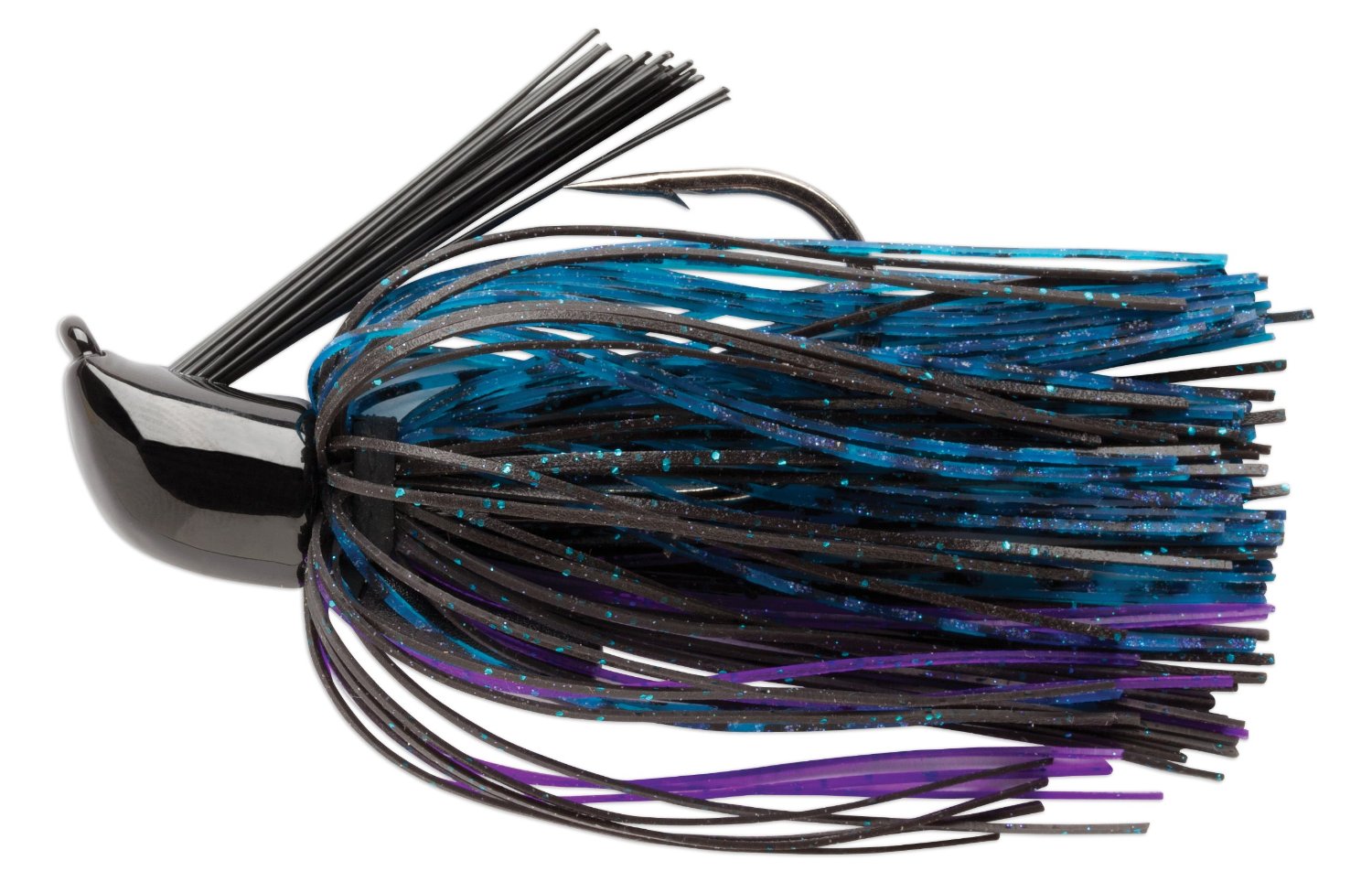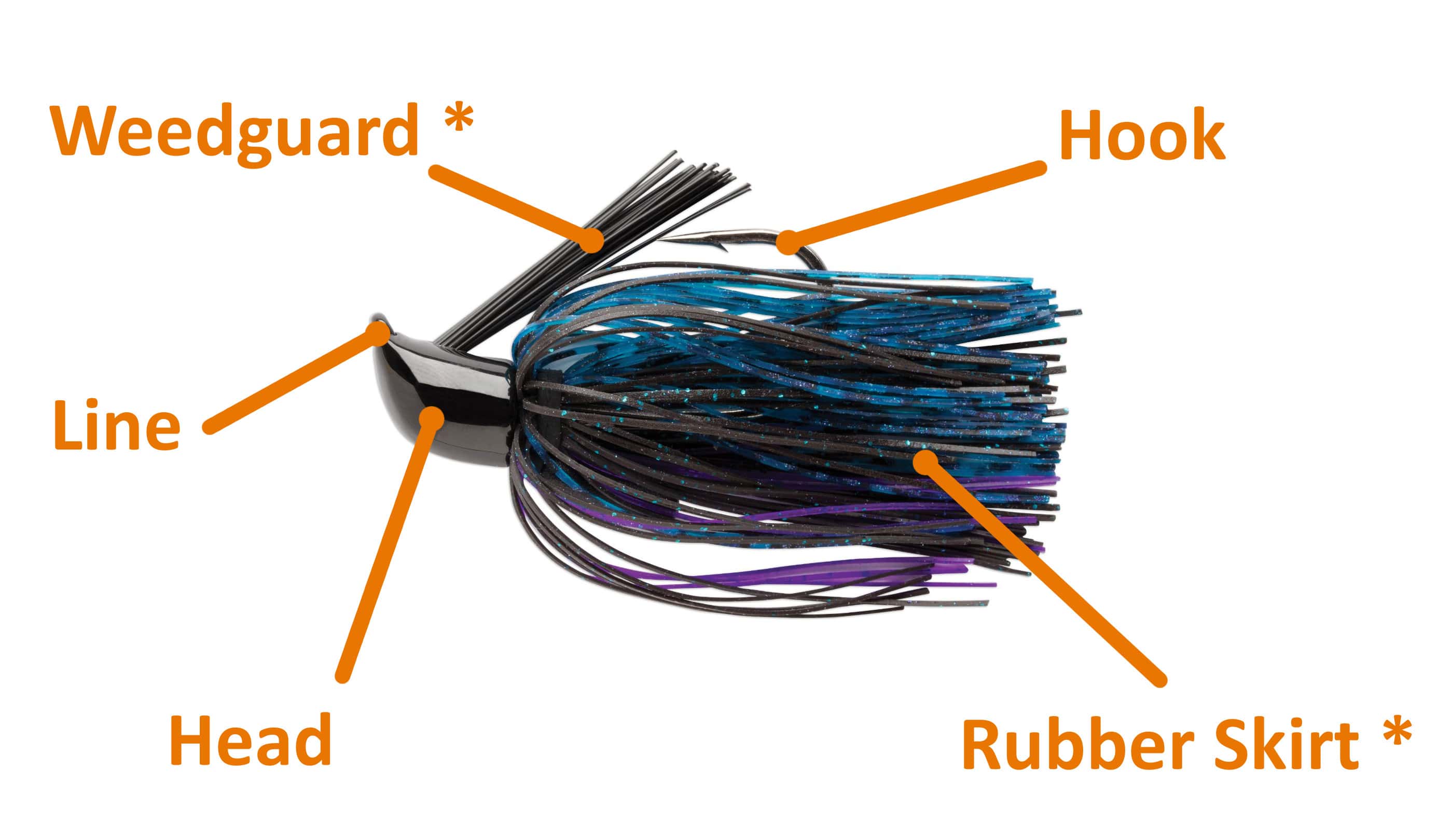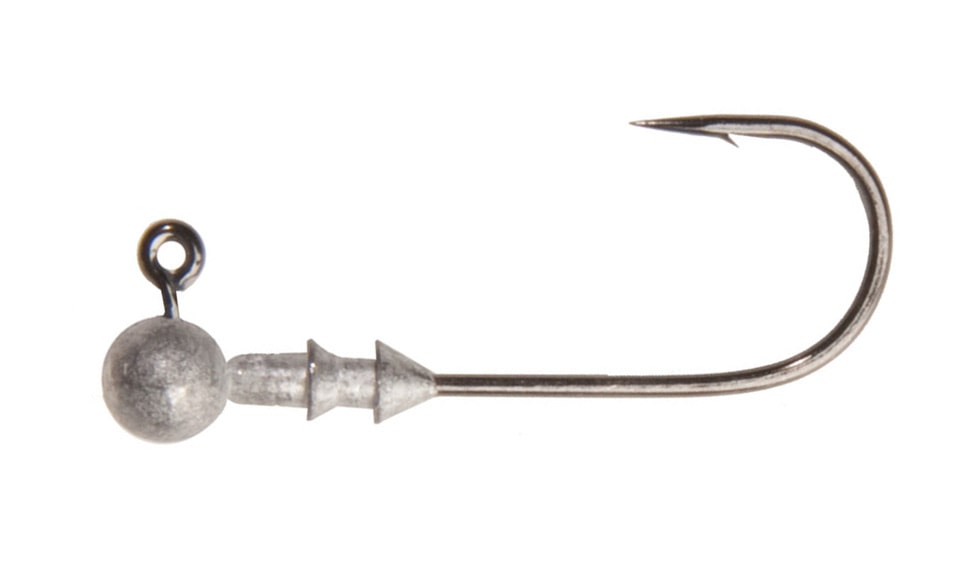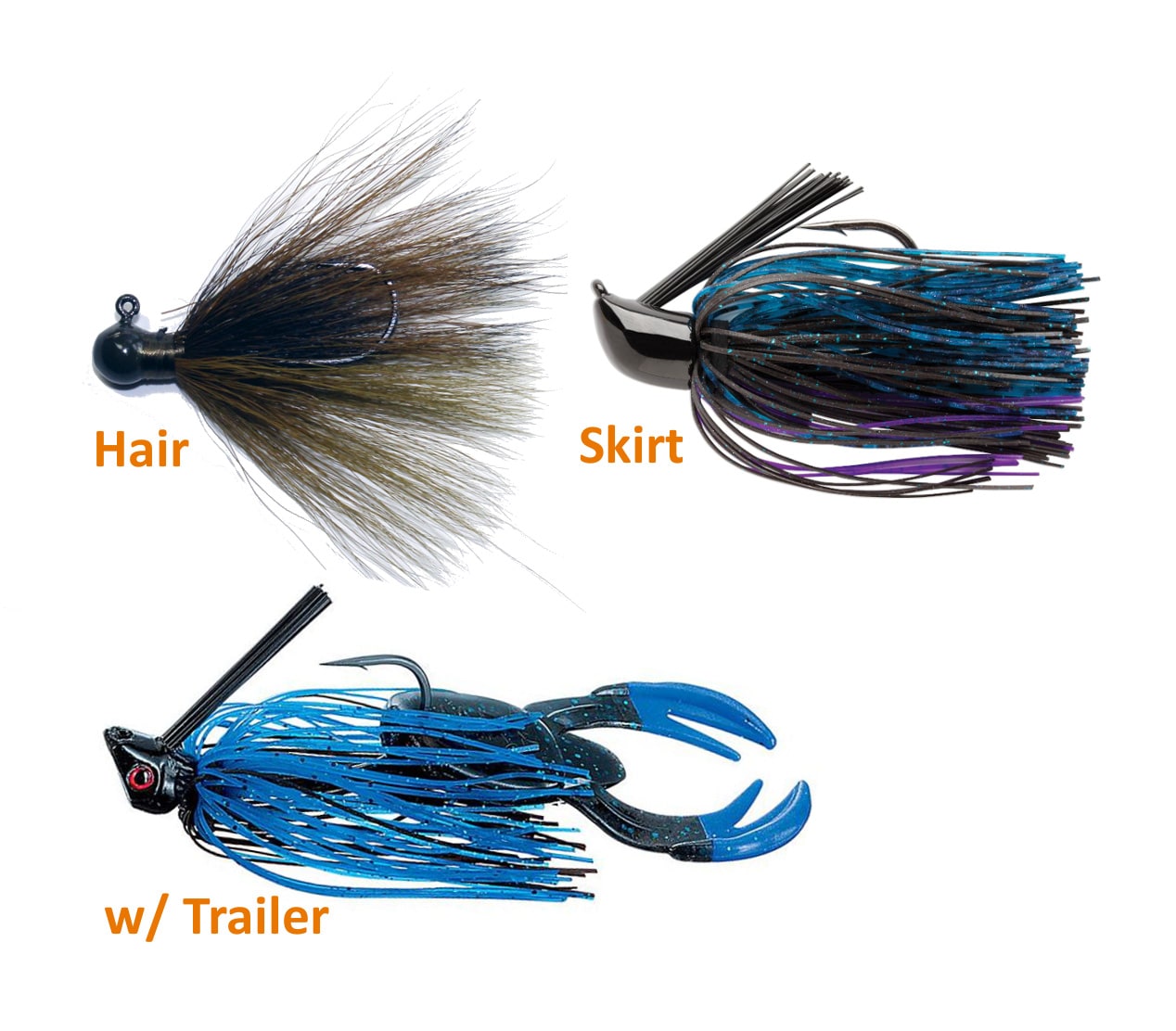How to Use a Jig

Jigs are quite a bit different from other lures like spinnerbaits or crankbaits, and therefore they require a different technique in order to maximize your chances of success. To be quite honest, we find a lot of this simply comes with experience, as they require a much more sensitive retrieval. Nevertheless, there are some general tips that will help get you started and avoid any bad habits right off the bat.
First, we will point out the different parts of a jig and discuss how they can affect your selection. They’re pretty simple overall, but understanding these different fishing gears will definitely increase your chances of success.
Parts of a Jig
The jig below is a fairly standard jig for fishing bass, but many other variations can work as well. This particular jig is the Terminator Pros jig. We like this one as it is quite robust in terms of applicability, so we decided to review it on our Best Bait for Bass article.

Jighead
The word “jighead” is usually used to describe the fundamental jig, which is simply the head combined with the hook. This itself is essentially common across all types of jigs, but the additional components such as hair, rubber skirt, weedguard, etc, are all used to optimize the jighead for particular conditions.

The image on the left is your standard jighead. These come in large variety of sizes and weights. The head itself is usually made of lead, which is very dense, so it provides a lot of weight for its small size. However, due to environmental concerns with lead (and some may even think health concerns) tungsten has also become popular. Some jigheads will also be encased in a thin rubber or plastic coating/casing, so the metal isn’t directly exposed. In any case, the main thing to know here is that the size and weight of jigheads is one of the most important factors to consider.
Check out the video below posted by BassBabyWebsite which has Gary Klein discussing some of the features of jigs (some more subtle ones, too) as well as some great demonstrations on casting and retrieving a jig.
What Size/Weight Jighead Do You Need?
Like any bait selection, this will depend largely on the conditions and species of fish you’re going after. Jigs come in a variety of weights/sizes, but they commonly range between 1/8 oz and 1.0 oz (that in itself is a really wide range!).
The general rule of thumb is to use the lightest jig possible, as you will want to have a very sensitive feel of the line and any potential bites. You also want to be able to feel any cover you end up hitting, as well as the bottom for when you initially drop/cast the jig.
So why can’t you just always use a 1/8 oz or lighter jig? The main factors at play here are water depth, current, and wind. You want the jig to be just heavy enough to hit the bottom, but usually the slower the fall, the better. However, if you find currents affecting the fall, or any heavy wind is pulling your line and keeping tension on the jig, then you may need something heavier to counter-act those factors, allowing the jig to drop to the bottom. You will want to be able to feel when it hits, ideally producing some slack in the line upon contact.
Hair, Rubber Skirts, and Trailers
These are the parts of a jig that really set them apart from each other. In the images of the jig above, we showed one that has a rubber skirt. This would be a great setup for fishing bass, especially the largemouth bass.

Hair jigs are often preferred in colder water temperatures when fish, especially bass, aren’t as active. The simple design provides very little, but some, action. Both on the drop and on retrieval, very slow movement will cause the hair to gently sway, mimicking a breathing action. Even gentle underwater currents will achieve this action, which is one of the reasons they work so well in colder water. Given these preferred conditions, they are more likely to be used in northern states, but anywhere during a time when the water is colder than usual can be a good time to try a jig with hair.
Trailers, like the crawfish one above, can be used in pretty much any condition. This is because different trailers will have varying action, so you can cater them to the water conditions. In colder water, some simple crawfish trailers with minimal action can work nicely, whereas something like a worm with a spinning tail can be ideal for warmer water when the fish are more active. Another advantage to trailers is that if you can’t get to a spot where you are essentially dropping the jig, crawfish and worm trailers can work well by employing a slightly longer cast. This way you can create a swimming action upon retrieval, but still utilize the classic jigging technique, essentially creating a combination between a standard retrieval and a jig retrieval (with a little more emphasis on the jig retrieval).
Jig Weed guards
A weed guard is a simple brush or thin piece of metal that provide a bit of protection for the hook. Weeds and another cover will hit the weedguard before making contact with the hook, and the subsequent deflection will usually allow the weeds or other covers to slide past the hook, thereby decreasing the chance of snags. This is great when you’re dropping a jig into thick cover where they can be extremely effective. The only downside is that it makes setting the hook a little more difficult, but it’s often a worthwhile trade-off.
Jig Hooks
There isn’t too much worth mentioning here. If you are fine-tuning the characteristics of your hook, chances are you are well experienced in working jigs. One thing to keep in mind is that if you have been using the same jig for quite a while, just make sure the hook is still nice and sharp, as it can be easy to forget about this. If you find that you’re losing lots due to snags and you’re also fishing for smaller fish, then a thin-wired hook may be a good option, so it can bend when snagged and you don’t need anything too big for those fish. On the other hand, if you’re fishing for larger fish that are a little more difficult to set the hook on and put up a bit more of a fight, then a thicker hook may be useful.
What is the Best Color for a Jig?
Again, like other lures, this depends on conditions, but keeping it simple is usually a good starting point. When the water is clear, simple and common lure colors work nicely. White can often be a good way to go with many lure types including jigs, or same with chartreuse. When there is lots of cloud cover or the water is murky, then anything that provides solid contrast without requiring reflection can work. It may seem unintuitive at first, but black can be a good option. This is typically what a fish would see anyway when the bait is above it because there wouldn’t be much light to reflect off the bottom of the bait and they would only see the shadow.
Personally, I’m a little bit conservative and usually try to select a bait, and subsequently a color, that will work in many situations. Therefore, I like to use a couple different colors, but keep those colors simple as well. Blue and black has proven to be successful for many anglers. I also like a pumpkin and green combo, particularly when using a trailer.
One thing to remember about choosing color is that we can do our best to optimize the bait for the given conditions, but so many things out of our control can affect underwater light conditions. Whether it’s passing clouds, any areas with more sediment in the water, or shadows produced from vegetation, stumps, and other covers, light conditions can change rapidly underwater. Again, that’s one of the reasons I like to use a couple different simple colors because I feel it’s worked out well for me in most conditions.
How to Properly Work a Jig
Hopefully, the information above has provided some useful information about selecting the proper jig for the given conditions. Once you have selected your jig, there are still some things to understand about the casting and retrieval that will be crucial for bettering your odds.
Drop to the Bottom
Unlike other lures like crankbaits or spinnerbaits, jigs are not meant to quickly cover large areas. Rather, they are most effective when dropped almost vertically into an isolated area, usually in or around heavy cover. It’s important to watch the line very carefully, as fish can often bite during the fall. It’s also crucial to allow the jig to reach the bottom before employing any sort of retrieval technique.
Once the jig hits the bottom (assuming a fish hasn’t already latched on) and some slack has formed, gently take in the slack and once it feels like there is any sort of tension, gently pull the rod vertically so the jig pops up a couple feet. Then, drop the rod back to a horizontal and reel in a little bit of the slack on the way back down. This will allow the jig to climb up the water column in a style that mimics a lot of easy prey found in areas of heavy cover.
For the majority of the retrieval, you may not be able to see your jig. This means you will rely much more on your sense of touch. Watching your line at the rod tip and feeling the line with your finger can be a good way to develop a feel for the jig. Some anglers will use a finger to press the line to the rod similar to how you may cast with a spinning reel. This allows you to feel the line more directly rather than relying on the feel of the rod where slight movements can become absorbed and go undetected. Remember, when you pull the jig upwards it will generate some slack, so if a fish takes the bait at that point, it can be more difficult to detect.
Check out the video below from 1Rod1ReelFishing demonstrating some effective casting and retrieval techniques for jigs.
Don’t Be Afraid of Heavy Cover
Jigs are often most effective in and around heavy cover, so try not to be afraid of losing them. While this will increase the chances of snags, it will also increase your chances of success, so it can often be a necessary trade-off.
Furthermore, the retrieval action of jigs is very gentle, so this can help guide your way through any thick cover. If the jig snags up briefly and you can free it up, this will actually create an action that can attract fish, especially bass, and often times you will notice that freeing-up from a snag will also result in feeling a bite.
Patience is a virtue, but it’s necessary when working a jig. Even if you’re fishing a jig in open flats, you need to take your time, use the proper technique, and don’t rush things. This can be frustrating at first, especially if you’re only used to using cranks or spinners, but it will definitely pay off. This also goes for when you hit a snag. If this happens, don’t just try and rip the jig out, but gently fiddle with it to see if you can get it to loosen up. Some anglers find it a good idea to provide some slack in the line if you hit a snag. This could allow the hook to drop a bit, and even if it doesn’t fully remove itself, it may loosen up enough that working it around a bit can allow you to recover it.
What Type of Line is Best for Jigs?
One of our final points about properly selecting and working a jig is pairing the correct line type. This is largely personal preference that you will develop over time, but the braided line, fluorocarbon line, or a combination of the two is usually preferred. It’s best to avoid the monoline, as it floats, has lower tensile strength, and also lower sensitivity. For more information on the general pros and cons of different line types, please click here.
As for the braided and fluorocarbon line, either can be good. Fluorocarbon is quite strong against abrasion, so can be good around rocks and wood. It also sinks the best out of all the line types and has a very high sensitivity, so it can be great in deep water. On the other hand, braided line is nice because it is more manageable, and while it may not sink quite as well as fluoro line, it still provides a high sensitivity and tensile strength.
As a compromise, many anglers choose to use a braided line with a few feet of fluorocarbon leader. This can help achieve the required depth without losing sensitivity or strength. We would suggest using a strong line as there’s a good chance you will be working through some thick cover and getting snagged up every now and then. A common selection, in this case, is 50 lb-test braided line, 20 lb-test fluoro line, or a combination of the two (fluoro as the leader).
